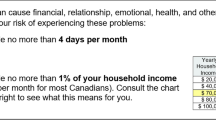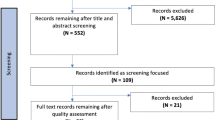Abstract
A set of low-risk gambling limits were recently produced using Canadian epidemiological data on the intensity of gambling behavior and related consequences (Currie et al. Addiction 101:570–580, 2006). The empirically derived limits (gambling no more than two to three times per month, spending no more than $501–$100°CAN per year or no more than 1% of gross income spent on gambling) accurately predicted risk of gambling-related harm after controlling for other risk factors. The present study sought to replicate these limits on data collected in three independently conducted Canadian provincial gambling surveys. Dose–response curves and logistic regression analyses were applied to gambling prevalence data collected in surveys conducted in 2001–2002 within the provinces of Alberta, British Columbia, and Ontario (combined sample N = 7,675). A comparable dose–response relationship between gambling intensity and risk of harm was found in each province. The optimal thresholds for defining an upper limit of low-risk gambling were similar across the three provinces despite variations in the availability and organization of legalized gambling opportunities within each region. These results provide additional evidence supporting the validity of the low-risk gambling limits. Quantitative limits could be used to augment existing responsible gambling guidelines.


Similar content being viewed by others
Notes
The analysis of the CCHS-1.2 data included gambling-related interpersonal problems as an additional negative consequence. This item was included in the AB and ON surveys but not the BC survey.
Detailed results with lottery play excluded are available from the authors on request.
References
Abbott, M. W., Williams, M. M., & Volberg, R. A. (2004). A prospective study of problem and regular nonproblem gamblers living in the community. Substance Use & Misuse, 39, 855–884.
Azmier, J. (2005). Gambling in Canada 2005: Statistics and context Calgary. AB: Canada West Foundation.
Blaszczynski, A., Ladouceur, R., Goulet, A., & Savard, C. (2006). “How much do you spend gambling?” Ambiguities in questionnaire items assessing expenditures. International Gambling Studies, 6, 128.
Breen, R., & Zimmerman, M. (2002). Rapid onset of pathological gambling in machine gamblers. Journal of Gambling Studies, 18, 31–43.
Campbell, C., & Smith, G. (2003). Gambling in Canada-from vice to disease to responsibility: A negotiated history. Canadian Bulletin of Medical History, 20, 121–149.
Cox, B. J., Yu, N., Afifi, T. O., & Ladouceur, R. (2005). A national survey of gambling problems in Canada. Canadian Journal of Psychiatry – Revue Canadienne de Psychiatrie, 50, 213–217.
Cunningham, J. A. (2006). Risk curves: Gambling with data. Addiction, 101, 1214–1215.
Currie, S. R., & Casey, D. M. (2007). Quantification and dimensionalization of gambling behaviour. In G. Smith, D. C. Hodgins, & R. J. Williams (Eds.), Research and measurement issues in gambling studies (pp. 156–173). Burlington, MA: Academic Press.
Currie, S. R., Hodgins, D. C., Wang, J., el-Guebaly, N., Wynne, H., & Chen, S. (2006). Risk of harm from gambling in the general population as a function of level of participation in gambling activities. Addiction, 101, 570–580.
Dawson, D. A. (2000). US low-risk drinking guidelines: An examination of four alternatives. Alcoholism: Clinical & Experimental Research, 24, 1820–1829.
DeLong, E. R., DeLong, D. M., & Clarke-Pearson, D. L. (1988). Comparing the areas under two or more correlated receiver operating characteristic curves: A nonparametric approach. Biometrics, 44, 837–845.
Felsher, J. R., Derevensky, J. L., & Gupta, R. (2004). Lottery participation by youth with gambling problems: Are lottery tickets a gateway to other gambling venues? International Gambling Studies, 4, 109–125.
Ferris, J., & Wynne, H. J. (2001). The Canadian problem gambling index final report. Ottawa, ON: Canadian Centre on Substance Abuse.
Grun, L., & McKeigue, P. (2000). Prevalence of excessive gambling before and after introduction of a national lottery in the United Kingdom: Another example of the single distribution theory. Addiction, 95, 959–966.
Grüsser, S. M., Plontzke, B., Albrecht, U., & Morsen, P. (2007). The addictive potential of lottery gambling. Journal of Gambling Issues, January, 19–30.
Ipsos-Reid & Gemini Research. (2003). British Columbia problem gambling prevalence study Vancouver. British Columbia: Ministry of Public Safety and Solicitor General, British Columbia.
Korn, D., & Shaffer, H. J. (1999). Gambling and the health of the public: Adopting a public health perspective. Journal of Gambling Studies, 15, 289–365.
Ladouceur, R. (1996). The prevalence of pathological gambling in Canada. Journal of Gambling Studies, 12, 129–142.
Lesieur, H. (1994). Epidemiological surveys of pathological gambling: Critique and suggestions for modifications. Journal of Gambling Studies, 10, 385–398.
Lesieur, H., & Blume, S. (1987). The South Oaks Gambling Screen (SOGS): A new instrument for the identification of pathological gamblers. American Journal of Psychiatry, 144, 1184–1188.
Marshall, K., & Wynne, H. (2003). Fighting the odds. Perspectives [Catalogue no. 75-001-XIE], pp. 5–12. Ottawa: Statistics Canada.
Petry, N. M. (2005). Pathological gambling: Etiology, comorbidity, and treatment. Washington, DC, American Psychological Association.
Raylu, N., & Oei, T. P. S. (2002). Pathological gambling: A comprehensive review. Clinical Psychology Review, 22, 1009–1062.
Responsible Gaming Council of Ontario. (2007). Tips for safer gambling. Retrieved February 23, 2007 from http://www.responsiblegambling.org/en/help/tips.cfm [On-line]. Available: http://www.responsiblegambling.org/en/help/tips.cfm.
Room, R., Bondy, S. J., & Ferris, J. (1995). The risk of harm to oneself from drinking, Canada 1989. Addiction, 90, 499–513.
Shaffer, H. J. (2005). From disabling to enabling the public interest: Natural transitions from gambling exposure to adaption and self-regulation. Addiction, 100, 1226–1239.
Shaffer, H. J., Hall, M. N., & Vander Bilt, J. (1997). Estimating the prevalence of disordered gambling behavior in the United States and Canada: A research synthesis. American Journal of Public Health, 89, 1369–1376.
Shaffer, H. J., LaBrie, R. A., LaPlante, D. A., Nelson, S. E., & Stanton, M. V. (2004). The road less travelled: moving from distribution to determinants in the study of gambling epidemiology. Canadian Journal of Psychiatry – Revue Canadienne de Psychiatrie, 49, 504–516.
Smith, G. J., & Wynne, H. J. (2002). Measuring gambling and problem gambling in Alberta using the Canadian Problem Gambling Index. Edmonton, AB: Alberta Gaming Research Institute.
Statistics Canada. (2003a). Survey of household spending. Ottawa, ON: Statistics Canada.
Statistics Canada. (2003b). Survey of household spending. Ottawa, ON: Statistics Canada.
Statistics Canada. (2006). Census family income. The Daily [On-line]. Available: Retrieved February 23, 2007 from http://www.statcan.ca/Daily/English/060525/d060525c.htm.
Swets, J. A., Dawes, R. M., & Monahan, J. (2001). Psychological science can improve diagnostic decisions. Psychological Science in the Public Interest, 1, 1–26.
Tabachnick, B. G., & Fidell, L. S. (2001). Computer-assisted research design and analysis. Toronto, ON: Allyn and Bacon.
Toce-Gerstein, M., Gerstein, D. R., & Volberg, R. A. (2003). A hierarchy of gambling disorders in the community. Addiction, 98, 1661–1672.
Volberg, R. A. (2007). Population surveys. In G. Smith, D. C. Hodgins, & R. J. Williams (Eds.), Research and measurement issues in gambling studies (pp. 33–51). Oxford: Elsevier.
Weinstock, J., Ledgerwood, D. M., & Petry, N. M. (2007a). Association between posttreatment gambling behavior and harm in pathological gamblers. Psychology of Addictive Behaviors, 21, 185–193.
Weinstock, J., Whelan, J. P., & Meyers, A. W. (2007b). Gambling behavior of college students: When does it become harmful? Journal of American College Health (in press).
Welte, J., Barnes, G., Wieczorek, W., Tidwell, M.-C., & Parker, J. (2004). Risk factors for pathological gambling. Addictive Behaviors, 29, 323–335.
Wiebe J., Mun, P., & Kauffman, N. (2005). Gambling and problem gambling in Ontario 2005. Toronto, ON: Responsible Gambling Council.
Wiebe J., Single, E., & Falkowski-Ham, A. (2001). Measuring gambling and problem gambling in Ontario. Ottawa, ON: Canadian Centre on Substance Abuse.
Williams, R. J., West, B. L., & Simpson, R. I. (2007). Prevention of problem gambling. In G. Smith, D. C. Hodgins, & R. J. Williams (Eds.), Research and measurement issues in gambling studies (pp. 400–425). Burlington, MA: Academic Press.
Williams, R. J., & Wood, R. T. (2004). The proportion of gaming revenue derived from problem gamblers: Examining the issues in a Canadian Context. Analyses of Social Issues and Public Policy, 4, 33–45.
Wood, R., & Williams, R. J. (2006). “How much money do you spend on gambling?” The comparative validity of question wordings used to assess gambling expenditure. International Journal of Social Research Methodology: Theory & Practice, 10, 63–77.
Acknowledgments
This project is funded by grants from the Alberta Gaming Research Institute and Ontario Problem Gambling Research Centre (Grant# 2475). The authors wish to acknowledge the assistance of Anja Karvinen who helped in manuscript preparation.
Author information
Authors and Affiliations
Corresponding author
Rights and permissions
About this article
Cite this article
Currie, S.R., Hodgins, D.C., Wang, J. et al. Replication of Low-Risk Gambling Limits Using Canadian Provincial Gambling Prevalence Data. J Gambl Stud 24, 321–335 (2008). https://doi.org/10.1007/s10899-008-9091-y
Received:
Accepted:
Published:
Issue Date:
DOI: https://doi.org/10.1007/s10899-008-9091-y




